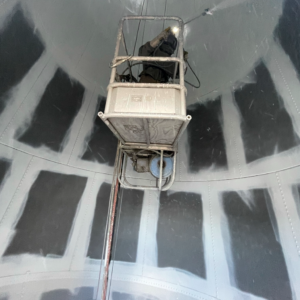
Fire safety is crucial in industrial settings, where the risk of fire hazards can be significant. Fire-resistant paints offer an effective way to help safeguard these spaces. These specialized coatings are designed to slow down the spread of fire, giving people more time to evacuate and protecting structures from extensive damage.
Understanding how fire-resistant paints function and their benefits can help industries make informed decisions about their safety strategies. These paints are formulated to react to high temperatures by swelling or creating a barrier, which minimizes heat transfer to the surfaces underneath, providing crucial protection during a fire.
There is more than one kind of fire-resistant paint available, and each type offers unique benefits suited for different industrial needs. With the right choice, businesses can enhance their safety protocols and contribute to a safer working environment for everyone involved. Proper application and regular maintenance of these paints ensure long-term effectiveness, helping to uphold safety standards and peace of mind.
Understanding Fire-Resistant Paints
Fire-resistant paints are special coatings designed to protect structures from fire damage. These paints play a crucial role in improving the fire safety of industrial spaces by slowing down the spread of flames. They are often used in environments where fire hazards are a concern, providing an extra layer of protection to building materials.
Fire-resistant paints work by reacting to high temperatures. When exposed to fire, the paint forms a thick, insulating barrier that helps prevent the heat and flames from reaching the surface underneath. This barrier can significantly delay the structural damage fire can cause, giving occupants more time to evacuate and first responders more time to control the fire. Additionally, these paints can reduce smoke production, aiding visibility and safety during an evacuation.
There are several benefits to using fire-resistant coatings in industrial settings. They preserve the integrity of steel structures and protect lives by decreasing the rate at which fire spreads. Understanding how these paints work helps businesses plan their safety strategies effectively, ensuring their facilities are well-protected against potential fire risks.
Types of Fire-Resistant Paints
There are two main types of fire-resistant paints: intumescent and cementitious. Each type serves specific purposes and offers advantages depending on the industrial application.
Intumescent paints are the more common type, known for their ability to expand when exposed to high heat. This expansion creates a thick, protective char layer that insulates the underlying surface from the heat. They are often used on steel beams and other structural elements because they provide effective fire protection without adding much weight. Intumescent paints are available in both water-based and solvent-based forms and can be applied up to a certain thickness depending on the required fire resistance level.
Cementitious paints, on the other hand, contain a mixture of cement and other fire-retardant materials. They do not expand when heated but create a rigid barrier against flames. These coatings are generally heavier and provide a durable surface that can also withstand harsh weather conditions. Cementitious paints are best suited for areas exposed to the elements or where a more permanent fireproofing solution is needed.
When comparing these options, it’s important to consider the specific needs of the industrial setting. Intumescent paints generally offer greater flexibility and are easier to apply in a thin, decorative coat. Cementitious paints provide robust, long-term protection and are often used in outdoor or weather-exposed areas. Understanding the strengths and applications of each type helps businesses choose the most effective fire-resistant paint for their specific industrial needs.
Selecting the Right Fire-Resistant Paint for Your Industry
Choosing the right fire-resistant paint involves understanding several key factors. First, consider the level of fire protection required by your industry. Different industries may have varying regulations and safety standards, affecting the type of paint needed. Industries with higher fire hazards, like chemical plants or warehouses, may need more robust fire-resistant coatings.
Evaluate the surfaces being coated. Metal and concrete may require different types of coatings, and the environment where the paint will be applied (indoor vs. outdoor) can also influence the decision. Think about the desired aesthetic finish—some paints offer smoother or glossier finishes than others, which might align better with specific industry needs.
Matching paint characteristics with the specific needs of your industry ensures optimal protection. Assess the durability, resistance to environmental factors, and application ease for potential paint types before making a choice. Taking these considerations into account helps maximize safety and effectiveness, while also maintaining compliance with safety standards.
Application and Maintenance of Fire-Resistant Paints
Applying fire-resistant paint correctly is essential for its effectiveness. Begin with a well-prepared surface by cleaning and ensuring it is free from dust, oils, or previous coatings. Next, follow the manufacturer’s application instructions closely, whether that involves spraying, rolling, or brushing the paint. Proper application ensures that the paint forms a uniform, protective barrier.
For best results, apply the paint in layers as recommended. The number of coats may vary based on the required level of fire resistance. Allow each coat to dry thoroughly before applying the next. This process helps enhance the paint’s fire protection capabilities.
Regular maintenance is critical for ensuring the longevity of fire-resistant coatings. Inspect the painted surfaces periodically for signs of wear, damage, or exposure to harsh conditions, which might compromise the protective barrier. Touch up areas where the paint is chipped or peeling and follow a regular maintenance schedule to keep the coating effective.
Conclusion
With industrial safety top of mind, selecting and applying the right fire-resistant paint plays a crucial role in safeguarding operations. Businesses can significantly reduce risks and enhance safety levels by addressing the unique challenges and requirements of their specific settings. As industries grow and adapt, staying equipped with the right fire protection solutions becomes even more important.
Let Procoat Painting Inc. help enhance the safety of your industrial space. Our expertise in industrial coatings ensures that you select and apply the best fire-resistant solutions for your needs. Visit our website or contact us to learn more about our services and take the next step in ensuring your space is protected.




